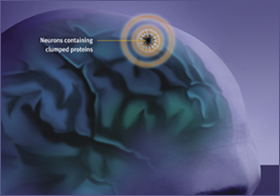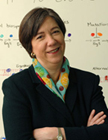| |
If you fold your socks wrong before putting them in your dresser, nothing bad will happen. But if you fold your parachute wrong before skydiving, something bad will happen.
Surprisingly, there's a similar effect in your body. Within your cells there are thousands of
different proteins. Each protein performs a task to keep your body going properly, but proteins need to be shaped in
a certain way to work right. If a protein gets misshapen or misfolded, it can stop doing the right thing and do real
damage instead. We can call this the "Jekyll and Hyde Effect".
In particular, misfolding a protein named alpha-synuclein may lead to Parkinson's disease (or PD), which devastates the body's motor system. If you have watched recent video of the actor Michael J. Fox,
you are familiar with the constant shaking that is one PD symptom. Mohammed Ali and Janet Reno are two other famous people with PD.
The symptoms of Parkinson's disease are tremor or shaking; stiffness of the arms, legs and body, slowness of movement; and trouble with balance (www.parkinson.org; www.ninds.nih.gov).
As the disease progresses, people may have difficulty walking, talking, or completing other tasks. Their arms or legs may shake when they are sitting quietly in a chair. Parkinson's disease is a progressive disease and, over time, symptoms will worsen and people will become more disabled; eventually they will die from complications of the disease.
Understanding the misfolding of alpha-synuclein and its consequences is the goal of Dr. Susan Lindquist and her team at the Whitehead Institute for Biomedical Research in Cambridge, Massachusetts.
What Happens
The motor system includes long cells called neurons that reach from the brain (or brain stem) down the spinal cord to control muscles. The motor pathways control posture, reflexes, and muscle tone, as well as conscious voluntary movements.
PD causes degeneration of a kind of neuron that produces the chemical dopamine. Dopamine coordinates the function of the body's muscles and movement. Without dopamine, the motor system cannot work right. |
|

Parkinson's Disease: Whiteboard |
It is estimated that once about 80% of the nerve cells that produce dopamine are damaged, people begin to experience the symptoms of Parkinson's disease (www.parkinson.org).
So the question is: what makes the dopamine producing cells stop working?
Can mistakes in protein folding cause Parkinson's Disease?
Dr. Susan Lindquist and a team of researchers at Whitehead study proteins and the problems that occur when proteins do not fold correctly. "Many different types of cells - from yeast to neurons - deal with protein folding in the same way," she says. So she can study this process in yeast, worms, fruit flies, animals and neurons.
How does this relate to Parkinson's disease?
"Our research has shown that Parkinson's disease is caused by a general problem in cell function," says Dr. Lindquist. The "problem" protein in Parkinson's disease is alpha-synuclein. She and her collaborators (Cooper et al. 2006) recently reported that a small amount of alpha-synuclein did not affect cell growth; but large amounts of alpha-synuclein resulted in misfolded proteins.
These faulty alpha-synuclein proteins collect near the cell membrane, and the cells became sick or died.
Using yeast cells, Dr. Lindquist and her team then wanted to see if there were other proteins that could help rescue the dying cells. They found the proteins most affected by alpha-synuclein were those responsible for moving proteins around the cell.
When misfolded alpha-synuclein clumps at the cell surface, it traps another protein called Ytp1p (protein names sometimes look like codes). Ytp1p acts like a protein traffic cop, and once it disappears from the cell, a "traffic jam" occurs that causes dopamine-secreting brain cells to die. Then the symptoms of Parkinson's disease appear (Cameron, 2006).
If there are large amounts of Ytp1p, some of it will be dragged away by alpha-synuclein, but the remaining amount will function correctly in the cell, as the protein traffic cop. Dr. Lindquist and her colleagues found that large quantities of Ypt1p prevent the cells from dying and restore them to life.
Yeast cells are easy to work with, but they don't have a nervous system. So, the team next tested rescue proteins on animal models of Parkinson's disease. To do this, she collaborated with other researchers who had developed models of Parkinson's disease in worms, fruit flies and rats.
The worm and fruit fly models have the alpha-synuclein gene. The researchers put the rescue protein Ypt1p into the developing animals, and watched them grow. In both worms and fruit flies the rescue protein rescued the cells. In other words, the cells lived and the worms and fruit flies did not develop Parkinson's disease.
In rats, the experiments were conducted on brain cells taken from rats that have been shown to develop Parkinson's disease. The rescue protein was put into dopamine-producing brain cells, and the results were the same - cell death ceased and the neurons returned to health.
Dr. Lindquist is currently using the "living test tubes" of yeast cells to screen chemical compounds that might be used as drugs. Some chemicals will remove alpha-synuclein from the cell, and others that will attach to alpha-synuclein and shut it down. Dr. Lindquist is hopeful that these studies will lead to the development of new drugs to help treat and prevent the development of Parkinson's disease.
| Dr. Susan Lindquist is a molecular biologist and an expert in protein folding. She studies protein folding in a number of diseases including Parkinson's disease, Huntington's disease and Mad Cow disease. She is a Professor of Biology at Massachusetts Institute of Technology, a member of the Whitehead Institute for Biomedical Research and the Howard Hughes Medical Institute at the University of Chicago. She is the director and co-founder of FoldRx, a company that develops drugs for the treatment of diseases of protein folding and amyloidosis, or the accumulation of abnormal proteins in various organs of the body. |
 |

Dr. Susan Lindquist |
To Learn More:
- Cooper AA, Gitler AD, Cashikar A, Haynes CM, Hill KJ, Bhullar B, Liu K, Xu K, Strathearn KE, Liu F, Cao S, Caldwell KA, Caldwell GA, Marsischky G, Kolodner RD, LaBaer J, Rochet J-C, Bonini NM, Lindquist S. alpha-Synuclein blocks ER-Golgi traffic and Rab1 rescues neuron loss in Parksinson's models. Science 313:324-328
- Cameron D. Traffic report. Paradigm Magazine Fall, 2006 available at www.whitehead.mit.edu/news/paradigm/fall_2006/traffic.html
- Khamsi R. Parkinson's traits reversed in rat brain cells. New Scientist 13:33, June 23, 2006 available at: www.newscientist.com/article/dn9396
- Bourzac K. Protecting neurons from Parkinson's disease. Technology Review available at: www.techreview.com
About
Parkinson's Disease :
About
Proteins:
Written by Andrea R. Gwosdow, PhD
Gwosdow Associates
HOME | ABOUT | ARCHIVES | TEACHERS | LINKS | CONTACT
All content on this site is © Massachusetts
Society for Medical Research or others. Please read our copyright
statement — it is important.
|
|
|
Parkinson's Disease
Parkinson's disease (PD) is estimated to affect between 500,000 (www.ninds.nih.gov) and 1.5 million people in the United States (www.parkinson.org), including Michael J. Fox. About 50,000 to 60,000 people are diagnosed with PD each year.
Right now, there is no cure for PD. There are a number of drugs that are used to help with the symptoms of the disease. Since PD is caused by a lack of dopamine, most drugs replace or mimic its effects. This can help with the symptoms of the disease. The exact cause of Parkinson" disease is not known, but scientists are helping us understand the underlying defect of the disease.
|
| |
 |

| Listen to a radio interview with Dr. Lindquist from June 23, 2006. Ira Flatow of National Public Radio" ScienceFriday asks her how research in yeast may lead to cures in animals and humans. Click on this link and then select your format - Real Audio, Windows Media or mp3 download.
© ScienceFriday, Inc. |
| |
 |

| In another radio interview, with Allan Coukell of WBUR, Dr. Lindquist explains her work in terms for non-scientists.
© WBUR |
| |
 |

| Click here for a 1-minute QuickTime movie of Dr. Lindquist explaining protein folding. © The Whitehead Institute, Inc.
|
| |
Sign Up for our Monthly Announcement!
...or  subscribe to all of our stories! subscribe to all of our stories!

What A Year! is a project of the Massachusetts Society for Medical Research.
|
|

